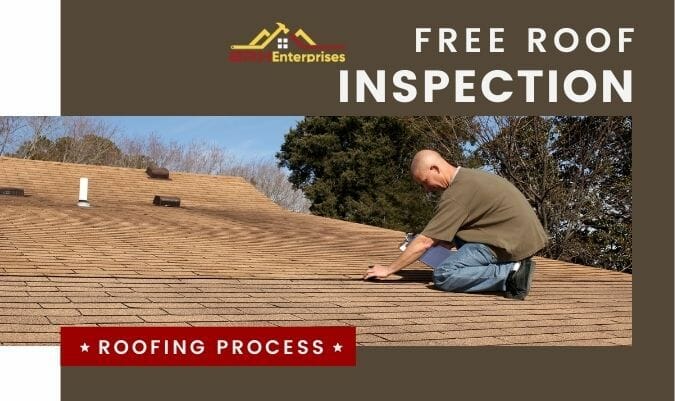
For Wisconsin homeowners, the age of your roof is often the most reliable predictor of when replacement becomes necessary. Just like any other part of your home, roofing materials deteriorate over time, and understanding this natural aging process helps you plan for future investments in your property.
All roofing materials have different life expectancies, ranging from decades to even centuries. While asphalt shingles typically last 20 to 30 years, metal roofs can protect your home for up to 70 years. The harsh Wisconsin climate, with its freezing winters, summer storms, and seasonal temperature shifts, all affect how quickly your roof ages and when replacement is needed.
Knowing where your roof stands in its lifecycle can help you decide between repairs vs. replacement. Many homeowners wait until they spot water damage or missing shingles before considering replacement, but being proactive about roof age can prevent interior damage and emergency roofing needs.
Southern Wisconsin’s weather patterns create specific challenges for roofing systems. Heavy snow, ice dams, and summer humidity all accelerate wear on roofing materials. A roof that might last 25 years in milder climates may need replacement several years earlier in Wisconsin. Tracking your roof’s age helps you anticipate replacement needs before problems develop, allowing plenty of time for budgeting and planning your roofing project.
Key Age Milestones for Different Roofing Materials
Understanding the expected lifespan of your roofing material is crucial when planning for replacement in Southern Wisconsin. Each material responds differently to our region’s challenging weather conditions, and knowing these age milestones helps homeowners prepare for the inevitable need for a complete overhaul.
Asphalt shingles are a common roofing material in Southern Wisconsin and typically last 20 to 30 years. The freeze-thaw cycles, heavy snowfall, and summer storms in our region can reduce their lifespan compared to milder climates. 3-Tab shingles fall on the lower end of this range, while architectural shingles often reach the upper limit.
Metal roofing systems demonstrate impressive longevity, with properly installed systems lasting 40 to 70 years even in severe weather conditions. Standing seam options typically outperform corrugated panels in our harsh winters. Slate and tile roofs can last 75 to 100 years, though they require specialized installation to handle Wisconsin’s snow. Wood shakes, once popular in our region, generally last 20 to 30 years but require significant maintenance to reach that milestone in our humid summers and snowy winters.
Manufacturer warranties often reflect these lifespans but typically cover materials only. Most premium roofing warranties for Wisconsin homes range from 25 to 50 years, depending on the material, with prorated coverage after initial periods. When evaluating warranty terms, remember that installation quality plays a significant role in how long your roof will actually protect your home.
How to Know if Your Aging Roof Needs to be Replaced
Recognizing the warning signs of an aging roof can save Wisconsin homeowners from expensive emergency replacements. As your roof approaches the end of its functional life, it begins sending signals that shouldn’t be ignored, especially given our region’s challenging weather conditions.
Visual indicators are often the most obvious signs that replacement time is approaching. Look for curling or buckling shingles, which occur when shingles begin to lose their integrity. Granule loss is another telltale sign — check your gutters and downspouts for small, gritty particles that have washed off your shingles. Bald spots, cracked shingles, and visible sagging indicate structural issues that demand immediate attention.
Not all roof damage is visible from the ground. If you’ve noticed steadily increasing energy bills, your aging roof may be losing its insulating properties. Interior moisture issues like water stains on ceilings or walls often originate from roof failures. Check your attic for signs of light penetration, moisture, or visible leaks after rain, as these conditions signal that your roof is no longer providing adequate protection.
Southern Wisconsin homeowners should be particularly vigilant after severe weather events, which can accelerate roofing deterioration. If neighboring homes of similar age are getting roof replacements, it’s wise to have your own roof professionally evaluated. Addressing these warning signs proactively can prevent more extensive damage to your home’s structure and interior.
How Wisconsin’s Climate Accelerates Roof Aging
Wisconsin’s climate can significantly shorten your roof’s lifespan compared to other parts of the country. The extreme temperature swings we experience, from scorching 90-degree summer days to subzero winter temperatures, cause roofing materials to expand and contract repeatedly, creating stress that leads to premature aging and deterioration.
The heavy snowfall in Southern Wisconsin presents another considerable threat to roofing systems. The weight of accumulated snow puts structural pressure on your roof, while the freeze-thaw cycles that follow create ideal conditions for ice dam formation. These ice dams trap moisture against your roof surface, potentially forcing water underneath shingles and into your home.
Spring and fall bring their own challenges with fluctuating temperatures that can trigger dozens of freeze-thaw cycles. Each cycle forces microscopic amounts of moisture into tiny cracks, which expand when frozen and contract when thawed, gradually widening these openings and accelerating deterioration.
Fortunately, strategic seasonal maintenance can significantly extend your roof’s lifespan despite these harsh conditions. Fall gutter cleaning prevents ice dam formation, while spring inspections can identify winter damage before it worsens. Professional roof maintenance, including debris removal, flashing inspection, and minor repairs, can add years to your roof’s functional life even in Wisconsin’s challenging climate.
The Financial Impact of Timely vs. Delayed Roof Replacement
Making the right decision about when to replace your roof has significant financial implications for Wisconsin homeowners. While delaying replacement might seem cost-effective in the short term, this approach often leads to higher expenses over time. Understanding the financial dynamics between preplanned and delayed replacement can help you make smarter decisions about your property.
When homeowners postpone roof replacement beyond recommended age milestones, they risk substantial secondary damage. Water intrusion through an aging roof can damage attic insulation, ceiling drywall, electrical systems, and even structural beams. These secondary repairs often cost far more than what would have been saved by delaying the roof replacement itself, especially during Wisconsin’s heavy precipitation.
Modern roofing systems offer energy efficiency benefits that older systems simply cannot match. Today’s shingles and underlayment materials provide superior insulation and reflection properties, potentially reducing heating and cooling costs compared to older roofing systems. This means the longer you wait to replace an aging roof, the more you’re likely paying in monthly energy bills.
Partial repairs on aging roofs might provide temporary relief, but they rarely address underlying deterioration. The cost of multiple repairs over several years typically exceeds what a complete replacement would have cost initially. Additionally, a new roof increases your home’s resale value, while an aging roof can become a significant negotiation point for potential buyers.
Professional Roof Assessment: Beyond Age Alone
While age provides a useful guideline for roof replacement, professional assessment delivers a comprehensive evaluation that looks beyond simple numbers. Wisconsin roofing professionals conduct thorough inspections that examine your roof’s actual condition rather than just its age. These assessments consider multiple factors that affect your roof’s remaining lifespan and replacement timeline.
Professional roof inspections include structural integrity evaluations that assess the roof deck, supporting structures, and overall roofing system stability. Certified contractors use moisture meters and thermal imaging to detect hidden water intrusion that might not be visible during casual observation. These specialized tools can identify potential problems long before they cause visible interior damage.
A qualified Wisconsin roofing contractor will evaluate your shingles’ granule loss percentage, assess flashing condition around chimneys and vents, and check for proper attic ventilation — all factors that significantly impact how much longer your roof can safely protect your home. They’ll also consider the specific pitch and exposure of your roof, as these elements affect wear patterns unique to your property.
Based on this comprehensive assessment, professionals can determine whether strategic repairs might extend your roof’s functional life by several years or if immediate replacement is the most cost-effective solution. This ensures Wisconsin homeowners receive recommendations based on their specific roofing system rather than generic age-based guidelines, potentially saving thousands in premature replacement costs.
Creating Your Personal Roof Replacement Timeline
Developing a realistic roof replacement timeline is essential for Wisconsin homeowners who want to avoid emergency situations and budget properly for this significant home investment. Your timeline should be personalized based on several key factors specific to your property, not just generic guidelines.
Start by documenting your roof’s current age and material type. If you don’t know when your roof was installed, a professional inspection can help estimate its age based on wear patterns typical in Southern Wisconsin homes. Next, assess its current condition through regular inspections, noting any warning signs like missing shingles, granule loss, or interior moisture.
Consider how your roof is aging compared to expected lifespans for your specific material in Wisconsin’s climate. A roof that’s showing significant deterioration at 15 years in a 25-year system suggests you should plan for replacement sooner rather than later. Evaluate your budget capacity, understanding that planning ahead allows for more financing options and potentially better pricing outside peak roofing seasons.
Document your roof’s condition with photographs at least annually, particularly after severe weather. Creating a log to track any changes, repairs, and maintenance performed provides valuable data for making decisions down the line. Many Wisconsin homeowners find that setting aside small amounts monthly toward eventual replacement makes the financial impact more manageable when the time comes.
Expert Roof Replacement Services by BRH Enterprises LLC
The age of your roof directly impacts the safety and efficiency of your home in Wisconsin. Each roofing material has a specific lifespan, which can be influenced by our local weather conditions. Knowing when to replace your old roofing system can save you from unnecessary repairs and energy inefficiencies. If you notice any signs that your aging roof needs replacement, such as curling shingles or interior moisture issues, it’s time to take action.
Call BRH Enterprises LLC today at (920) 249-4228 to schedule a professional roof assessment. Let us help you create a personalized roof replacement timeline that aligns with your home’s specific needs and budget. Don’t compromise on the safety and comfort of your home — contact us for expert guidance and service.

Bryce, Master Roofer
Protect Your Home with Expert Roofing
Don’t wait for leaks or storm damage to cause costly repairs. Our experienced roofing team provides fast, reliable service, high-quality materials, and lasting results. Ensure your home stays safe, secure, and looking great—contact us today for a free estimate.




